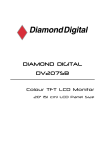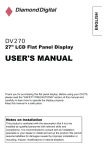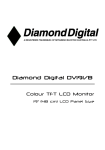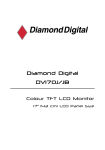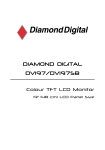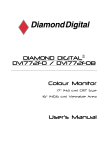Download Diamond Digital DV226BW Specifications
Transcript
DIAMOND DIGITAL DV226BW Colour TFT LCD Monitor 22.1” (56cm) LCD Panel Size Copyright 2001, Mitsubishi Electric Australia Pty. Ltd. All rights reserved. No part of this publication may be reproduced, transmitted, transcribed, stored in a retrieval system or translated into any language or computer language, in any form or by any means, electronic, mechanical, magnetic, optical, chemical, manual or otherwise, without the prior written permission. Table of Contents 1 2 3 4 5 6 7 8 9 10 Important Safety Instructions ..........................................1 Features.............................................................................2 Unpacking the Monitor .....................................................3 Hardware Installation .......................................................5 Windows Driver Installation.............................................6 Setting the Display Resolution ........................................7 Choosing the Best Resolution...........................................7 Supported Graphics Modes and Refresh Rate Selection..8 Adjusting the Monitor..................................................... 11 Picture Optimisation........................................................11 Manual Picture Adjustment .............................................11 Restoring the Factory Default Settings ...........................14 On Screen Display Functions .........................................14 Frequently Asked Questions .........................................15 Specifications .................................................................17 Service Contacts.............................................................19 Disclaimer Mitsubishi Electric Australia Pty. Ltd. makes no representations or warranties, either expressed or implied, with respect to the contents hereof and specifically disclaims any warranties, merchantability or fitness for any particular purpose. Further, Mitsubishi Electric Australia reserves the right to revise this publication and to make changes from time to time in the contents hereof without obligation to notify any person of such revision or changes. i Diamond View is a registered trademark of Mitsubishi Electric Australia Pty. Ltd. Microsoft and Windows are registered trademarks of Microsoft Corporation. All other trademarks remain the property of their respective owners. Reference Information For future reference, write the following information about your monitor in the space below. The serial number is found on the back of the product or on the bottom of its stand. Monitor Information Product Name: Diamond Digital DV226BW Serial Number: Date of Purchase: Dealer Information Dealer: Telephone Number: Address: ii 1 Important Safety Instructions Please read the following safety instructions before installing or cleaning your Diamond View monitor: 1. Unplug the monitor’s power cable from the wall outlet before cleaning. Do not use liquid or aerosol cleaners. Use a soft cloth to clean the monitor housing. 2. Slots and openings on the back or top of the cabinet are provided for ventilation. They must not be blocked or covered. This product should never be placed near or over a radiator or other heat source, or used in a built-in installation unless proper ventilation is provided. 3. Never push objects of any kind, or spill liquid of any kind into this product. 4. Do not attempt to service this product yourself as opening or removing covers may expose you to dangerous voltages or other hazards. 5. If any abnormal operation or accident (such as dropping the unit) occurs, disconnect the monitor from the wall power outlet and contact qualified service personnel. 6. Turn the audio volume control of the built-in speakers to minimum (0) and turn the monitor off before connecting or disconnecting any audio cable. 1 2 Features Your Diamond Digital DV226BW monitor features: ♦ Native (Maximum) Resolution: 1680 x 1050 @ 60Hz ♦ High Brightness – 300 cd/m2 ♦ High Contrast Ratio – 700:1 ♦ True Colour Display The Diamond Digital DV226BW monitor supports 16.7 million colours. ♦ High Quality Ratiometric Expansion The Diamond Digital DV226BW can expand any resolution within the monitor’s specified range to full screen. ♦ Auto Adjustment Function The auto-adjustment key automatically optimises the displayed image. ♦ Plug and Play Compatibility with Microsoft® Windows® 2000 and XP ♦ Dimensions (WxHxD): 513.76mm x 418.2mm x 67.34mm ♦ Light Weight - only 5.9 kg (net) ♦ Low Power Consumption 55 W maximum during operation. ♦ Power Saving Power management complies with VESA DPMS standard. When the system is idle (in monitor standby mode), the monitor power consumption drops to less than 4W. ♦ On Screen Display Allows you to adjust all settings simply using on-screen menus. ♦ Built-in 1W Stereo Amplifier and 8Ω Speakers 2 3 Unpacking the Monitor Please check that the following items are included with your monitor. If they are missing or damaged, please contact your place of purchase immediately. LCD monitor User’s Manual Audio Cable r's Use nual Ma D-sub (VGA) cable DVI cable Power Cord Locate the model name and the serial number label on the back of your monitor, and write the details of the monitor and your place of purchase in the space on page (ii) of this manual for future reference. 3 4 Hardware Installation Your monitor is equipped with a power supply with a voltage range from 100 to 240 Volts AC at a frequency of 50 to 60 Hz. Make sure that your local power supply is within the supported range. If you are unsure, please contact your electricity supplier. To install your Diamond Digital DV226BW monitor: 1. Please ensure the computer and monitor power cables are both unplugged. 2. Attach the monitor’s D-sub signal cable to the VGA output on the videocard, located at the back of the computer. Attach the other end to your LCD monitor. 3. If a DVI port is available on your videocard, you should use this instead of the D-sub (VGA) port. The DVI port will provide crisper text and a clearer picture. 4. Connect the stereo audio cable from the audio jack on the monitor to the audio output of your computer’s sound card. 5. Connect the power cord from the monitor’s power jack to an AC power socket. Please make sure that you have easy access to the power socket so you can disconnect the unit from the power socket if needed. 4 5 5 Windows driver installation The DV226BW is fully Windows compatible so no specific Windows drivers are required to be loaded. Windows 98, ME, and 2000 After connecting your new monitor, the system will detect the monitor and automatically start the Add New Hardware wizard. Follow the prompts to load the Plug and Play drivers. Windows XP and 2000 Windows XP and 2000 will automatically load the Plug and Play drivers. 6 6 Setting the Display Resolution Choosing The Best Resolution All LCD panels have a native resolution, which is the maximum resolution that may be displayed on the LCD panel. In the case of the DV226BW the native resolution is 1680 x 1050 pixels. Lower resolutions can still be displayed at full screen, however as the lower resolution must be expanded, the quality of the displayed image is not as good as when the native resolution is displayed. For best performance from any LCD monitor, you must use the monitor’s native resolution. If you are using Windows 2000 or XP, you can change the resolution as follows: 1. Double-click the Display icon in Control Panel. 2. From the Display Properties dialogue box, select the Settings tab. Set the resolution to 1680 x 1050 using the resolution slider. 3. Click OK to close Display Properties. If you are using an Apple Macintosh, change the resolution by doing the following: MacOS 8.x/9.x 1. Click the Apple icon at the top, left corner of the screen, select Control Panel and then select Monitors. 2. Select a resolution of 1680 x 1050 pixels with 60Hz refresh rate. 3. If 60Hz is not available, click Recommended in the Show drop-down box 7 and change it to All. Select the resolution and refresh rate as above. A colour depth of either Thousands or Millions is recommended. MacOS X 1. Click the Apple icon at the top, left corner of the screen, select System Preferences and then select Displays. 2. Select a resolution of 1680 x 1050 pixels with 60Hz refresh rate. 3. A colour depth of either Thousands or Millions is recommended. Supported Graphics Modes and Refresh Rate Selection There is no need to choose the highest possible refresh rate when using an LCD monitor. For best results, set your videocard to display the native resolution of the LCD monitor. Other video resolutions may be displayed poorly or not at all. Note that the DV226BW’s preset modes correspond to VESA or Apple Macintosh standard graphics signals for these resolutions. All recent models of videocards should be able to support these modes. For the native resolution of 1680 x 1050 pixels, the refresh rate should be set to 60Hz. To change the refresh rate of the videocard for Windows 2000 or XP: 1. Right click an empty space on the Desktop, then select Properties. 2. Click the Settings tab, then click Advanced. 3. Select the Monitor tab. Click the drop down box to select a refresh rate. 4. Select a refresh rate of 60Hz, for best results. 5. Click Apply, and then OK twice. 8 Please Note: • Some graphics modes may not be supported. For an optimal picture it is recommended that you select 1680x1050. The default setting may require some adjustment using the monitor’s OSD before use. • The displayed image may show some distortion or noise that can be caused by the signal from the VGA card if it does not correspond with the usual standard. This is not a problem with the monitor. If it is still visible after using the Automatic adjustment, you can usually improve the displayed image by manually adjusting the phase, horizontal position and pixel frequency settings using the "Image Adjust" menu. See Chapter 7, Adjusting the Monitor, for more details. • When you shut down Windows you may see interference lines on your screen. This is caused by the manner in which Windows controls the videocard at this point and is normal with all LCD monitors. • To extend the service life of the product, we recommend that you use your computer's power management functions to turn the monitor off after extended idle periods. 9 7 Adjusting the Monitor Picture Optimisation Press the Auto button, to optimize the picture. This works best if the videocard is set to display the native resolution of the LCD monitor, and if a suitable stationary image is displayed. (such as the desktop). The monitor will remember the settings obtained by the auto calibration settings and use them whenever you turn the monitor on. Note that you may need to readjust the monitor if it is connected to a different computer or if the computer’s videocard is replaced. If you are still not satisfied with the result, you can enhance the image by using the monitor’s manual adjustment functions. 10 Manual Picture Adjustment Adjustments to the displayed image and audio volume are made using the On-Screen Display (OSD), and the buttons on the front of the monitor. 1 Power LED 2 POWER 3 AUTO Power light Blue is On, Orange is standby mode. Power On/Off Power Switch Blue-Operation mode / Orange-Power saving mode OSD Off: Executes auto adjustment Auto Adjustment function. Button OSD On: Confirms an OSD selection. 11 4 5/6 MENU OSD Function <> Left Button Decrease Button Enters / Exits OSD OSD Off: Pressing < or > can directly adjust the “volume” and brightness. OSD On: Use these buttons to adjust the values of a selected function. To Manually adjust the image: 1. Display a test pattern image on the monitor. This is the best way to observe changes as you adjust the image. Alternatively, a stationary image may be used, preferably one with small text or thin vertical lines. 2. Open the OSD menu by pressing the MENU button on the monitor. 3. Press < or > to highlight the Image Control menu, then press AUTO. 4. Press < or > to highlight Clock, then press AUTO to select. 5. Press < or > adjust, then MENU to exit. 6. Increase or decrease the Clock setting to get the optimum picture. If some noise or distortion is still visible in the centre section of the test pattern, try adjusting the Phase option in the Image Control menu. 7. Close the phase submenu by pressing MENU. 12 8. Select H-Position or V-Position and press AUTO. Adjust the horizontal and vertical position so that the image is centred. Its width and height should be the same as the visible width of the screen. Close this submenu by pressing MENU. 9. Press MENU to close the OSD menu and save your changes. If you are still not satisfied with the result, check the videocard is set to native resolution the refresh rate is set to 60Hz, before repeating this procedure. Please Note: You must use one of the factory modes. If the Auto button is not working, or the NO SUPPORT message is shown on the OSD, you are not using a supported resolution. If you are having difficulties selecting a supported mode, ask your computer dealer, or the manufacturer of your graphics card for assistance. The procedures described in this chapter should be performed for every resolution and type of graphics signal that you wish to use. For example, if a particular application requires a resolution of 800 x 600 pixels, but all other applications use the monitor’s native resolution, you will need to display the test pattern and make adjustments twice. The monitor will remember your settings and use them whenever you turn the monitor on. Note that you may need to re-adjust the monitor if it is connected to a different computer or if the videocard is replaced. 13 On Screen Display (OSD) Functions The On Screen Display (OSD) provides functions that allow you to adjust the displayed image, change the audio volume, reset the monitor and get information about the displayed graphics signal. The OSD has five functional groups for Brightness/Contrast, Image Control, Color, OSD Control, Other. Brightness/Contrast Brightness and Contrast adjustments. Image Control Auto Adjustment – Optimises the picture quality for the current resolution. H/V Position – Adjusts the Horizontal and Vertical picture position. Clock – Adjusts the sampling frequency for the Analogue (VGA) to Digital signal conversion. Phase – Adjusts the phase of the pixel clock to eliminate sampling noise. Color Adjusts the colour temperature of the display. OSD Control Adjusts the OSD position and timeout settings. Other Language – Selects the language for the OSD Input – Selects which signal input to use analogue D-sub (VGA) or Digital DVI. Speaker Volume - Adjusts the monitor speaker volume level. Information – Indicates the newly adjusted resolution settings, including horizontal and vertical frequencies. 14 8 Frequently Asked Questions The image is blurred, how can I get the best quality picture? ♦ ♦ Read chapter 6, Setting the Display Resolution, and select a video signal with the correct resolution and refresh rate. Then read chapter 7, Adjusting the Monitor, and make adjustments to the displayed image based on these instructions. Have you used a VGA extension cable? If so, remove the extension cable and check the displayed image. Has the image quality improved? Optimise the image using the procedures in chapter 7 with the extension cable removed. Reconnect the extension cable once the image has been optimised. Depending on the characteristics and type of the extension cable, some blurring or distortion may occur due to conduction losses of the extension cable. You can minimise these losses by using an extension cable with better conduction quality or with a built-in booster. ♦ Does the blurring only occur at resolutions lower than the native (maximum) resolution? Please read chapter 6, Setting the Display Resolution. Select a graphics signal that uses the monitor’s the native resolution (1440x900 pixels). Why does the image look yellow, blue or pink instead of showing the correct colours? ♦ The most common cause of this problem is a loose VGA signal cable or connector. Check that the cable is securely connected to the computer. ♦ Check the VGA signal cable for damage. If any pins are bent or broken off, contact your dealer or an authorised Mitsubishi Electric service agent (see Chapter 10 for details). 15 No image is displayed, what can I do? ♦ Check that the light (LED) next to the monitor’s power button is lit and is blue in colour. If the LED is blue, press the MENU button on the monitor to access the On Screen Display. If the message NO SUPPORT appears there, please read chapter 6, Setting the Display Resolution and reset the graphics card to one of the monitor’s supported graphics signals. ♦ If the LED is orange the monitor is in power saving mode. Press a button on the computer keyboard or move the mouse to wake the computer. If that does not help, check that the VGA cable is securely plugged into the computer. Also check the pins of the VGA cable’s connector. If any pins are bent or broken off, then contact your dealer (see Chapter 10 for details). ♦ If the LED is not lit at all, check that the monitor is plugged into the power supply mains socket and that the power switch is turned on. Check that the monitor’s power switch is also turned on. The image is or distorted, flashes or flickers: ♦ Check that the monitor’s signal cable is securely connected to the computer. ♦ Read the chapters 6 and 7 of this manual, then select the correct resolution, refresh rate and make adjustments based on these instructions. The image is displaced in one direction: ♦ Use the H-Position (horizontal position) adjustment in the Image Control menu of the monitor’s OSD to reposition the image. ♦ Read the chapters 6 and 7 and then select the correct resolution, refresh rate and make adjustments based on these instructions. 16 9 Specifications Model: Diamond Digital DV226BW Display Characteristics Display Type 22.1“ diagonal widescreen TFT LCD Viewable Diagonal Area 56 cm / 22.1” Native (Maximum) Resolution 1680 x 1050 pixels Colours 16.7 million Contrast Ratio 700:1 (typical) Brightness 300 cd/m² (typical) Response Time 5 ms typical (Tr + Tf) Viewing Angle (Horizontal, Vertical) 170°, 160°(typical) Dot Pitch 0.264 mm User Interface Controls Power switch, Auto adjust, < or > and Menu. On-Screen Display Functions Brightness/Contrast, Image Adjust, Audio, Phase, Colour, OSD Setup, Advanced, Information Input Signal Line Frequency 31 - 83kHz , 56 ~ 75Hz vertical Image Frequency (Refresh Rate) 56 - 75Hz 17 Video Signal Analogue VGA Digital DVI Signal Connection 15-pin VGA, 24-pin DVI-I Physical Characteristics Power Management VESA DPMS, Energy Star Maximum Power Consumption 55 Watts (Blue LED) Power Saving Mode < 4 Watts (Orange LED) Operating Voltage 100 - 240 VAC, 50 - 60 Hz Dimensions (W x H x D) 513.76 x 418.2 x 67.34mm Weight 5.9 kg (net) Temperature (Operating) 0°C - 40°C Air Humidity (Operating) 20% - 80% Safety AS/NZS 60950 EMI/EMC AS/NZS Cispr22 (C-Tick), Other TCO-99, ISO-13406-2 18 10 Service Contacts If problems persist after checking this manual, please contact your place of purchase or contact: Australian Service Contacts Visit the Customer Support section of Mitsubishi Electric Australia’s web site at www.mitsubishielectric.com.au for details of your nearest Mitsubishi Electric Authorized Service Center or contact the Service Department for your state: New South Wales and Australian Capital Territory 348 Victoria Road Rydalmere, NSW, 2116 Telephone: (02) 1300 651-808 Fax: (02) 9684-7684 Queensland Unit 12 468 Nudgee Road, Hendra, QLD, 4030 Telephone: (07) 3623-2000 Fax: (07) 3630-1888 South Australia and Northern Territory 77 Port Road Hindmarsh, SA, 5007 Telephone: (08) 8340-0444 Fax: (08) 8340-0555 19 Victoria and Tasmania 4 / 303 Burwood Hwy East Burwood, VIC, 3151 Telephone: (03) 9262-9899 Fax: (03) 9262-9850 Western Australia 5 / 329 Collier Road Bassendean, WA, 6054 Telephone: (08) 9377-3411 Fax: (08) 9377-3499 20



























